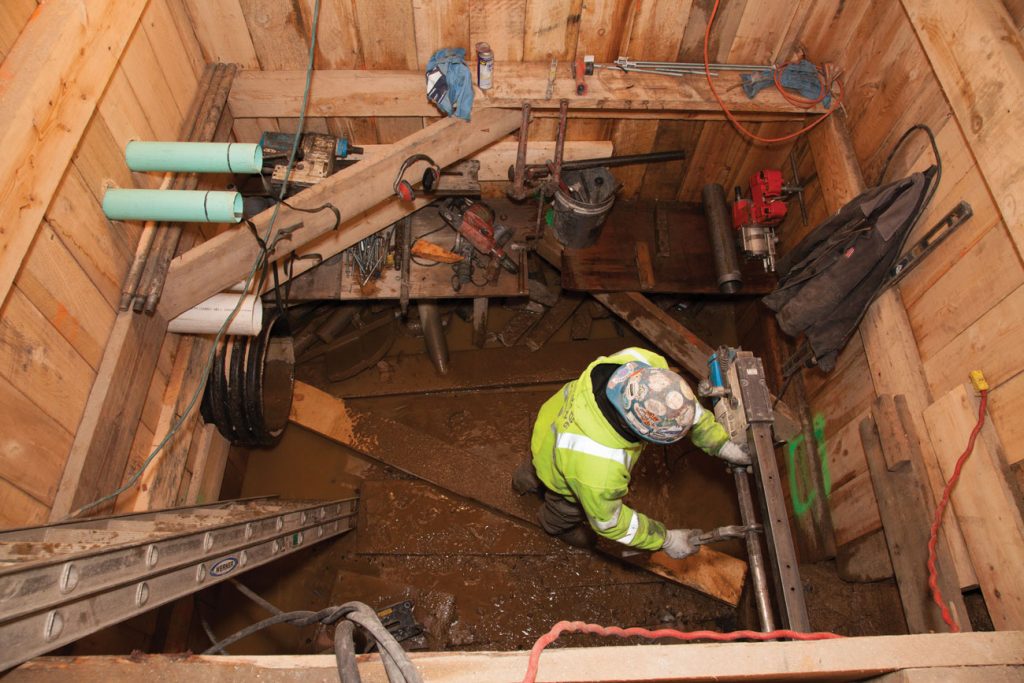Sustainable Innovation with Historic Preservation
When it comes to sustainability, New York City is now looking to one of the oldest institutions in the world—the Catholic church—as an innovator. As part of its nearly $200-million restoration effort, St. Patrick’s Cathedral recently updated its heating and cooling system, opting to install a 240-ton geothermal system that uses the ground’s energy to regulate building temperatures.
 Go to https://stobuildinggroup.com/wp-content/uploads/2018/05/Geothermal-rendering_Zubatkin_web.jpg
Go to https://stobuildinggroup.com/wp-content/uploads/2018/05/Geothermal-rendering_Zubatkin_web.jpg
BELOW GROUND
During planning, the project team assessed other, more traditional options, but complications arose given the cathedral’s historic nature and limited space. “Many buildings have cooling towers on their rooftops. But at St. Patrick’s, there is no roof to hide them,” says Paul Keosayian, Structure Tone project manager. “Another idea was to build a full mechanical plant, but that quickly became cost prohibitive due to the amount of rock excavation and foundation work required.”
Excavation was obviously part of the process for a geothermal system as well, but in a much more specific, less obtrusive way. Digging the wells involved a special truck with a drill rig on the back, slowly moving from well site to well site along the cathedral’s lawn. Over the course of almost a year, the team drilled 10 wells, each anywhere between 600 and 2,200 feet below the ground and carefully planned around the complex maze of Manhattan’s underground infrastructure. The project team also coordinated closely with the ongoing building renovations, scheduling the drilling and associated system installations to avoid impacts to that progress.
“We barely had to touch the cathedral itself since the physical plant is in a basement area,” Keosayian says. “All of the underground piping went through the gardens and crawl space areas with just a few spots where the system attaches to the building.”
TIGHT QUARTERS
Space was a defining challenge of the project since so much work was happening at once, and the geothermal system design is extremely compact. Weaving the supply and return lines from the south side of the cathedral to the physical plant involved drilling several 10-inch-diameter holes through 18 feet of foundation, plus 12 more holes through knee walls in the crawl space every 12 feet. Once the piping was installed and electrical conduits were roughed out, the team then had to seal those openings to ensure they were secure and water tight. Needless to say, all of this work was done in very tight spaces, requiring extra safety oversight and monitoring.
“The crawl space was about three feet high, and many of the areas we worked in were similarly confined,” says Keosayian. “This required special confined spaces permitting and training, plus constant monitoring to make sure everyone stayed safe.”
Fitting all of the equipment into the cathedral site’s footprint also required some intense coordination. Structure Tone worked together with the engineering team to make the system all fit together, plus meet expectations for aesthetics, serviceability and functionality. The plant itself includes not only the chiller and a cooling tower for backup, but also 10 heat exchangers, more than 20 pumps and, as Keosayian puts it, “what seemed like miles of piping.”
But in the end, he says, all that effort was worth it. “It was so rewarding to see that once everything was complete and the areas were landscaped, no one would ever know there are wells in the gardens and all the other components that support them.”
INTO THE FUTURE
The geothermal system went online in February of 2017, and the church is looking forward to the efficiencies it will bring. They are also proud of the model they provide for others looking to be more environmentally resourceful.
“We are now heating and cooling the cathedral with renewable energy, reducing our carbon footprint and making our city that much greener,’’ Msgr. Robert T. Ritchie, St. Patrick’s rector, noted in a message to members. “We are very grateful for this opportunity to do our part as stewards of creation.”
Project Details
Client: St. Patrick’s Cathedral
Architect: Murphy, Burnham & Buttrick Architects
MEP Engineer: Landmark Facilities Group
Geothermal Engineer: PW Grosser Consulting
Structural Engineer: Silman
Site Engineer: Langan Engineering
Owner’s Rep: Zubatkin Owner Representation, LLC
Services: Construction Management
Sector: Cultural
Completion: February 2017
Rendering courtesy of Murphy, Burnham & Buttrick Architects. Photo courtesy of Michael Verzella, Structure Tone.

